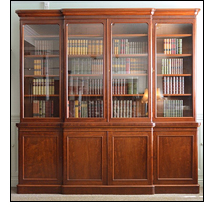featured item

outstanding quality antique victorian carved oak barometer Read more
Antique Bookcases
Posted by Gill Jones on 21/10/2013
 When did people start placing books inside bookcases? Surely, the need for books has always been around? No, not really. Once books were handwritten and they were far rarer than they are today. Books were for the rich, for those who could afford them, who carried them inside expensive and often ornately designed boxes. And this is how your average book would have been stored, inside a box and laid flat, once the title was written across the spine of the book they were then stored upright. Cupboards that stored books then had their doors taken off so the books could be seen and you could pull a book from the shelf. This kind of cupboard design, namely the bookcase is what we have today and it originated from the Middle Ages.
When did people start placing books inside bookcases? Surely, the need for books has always been around? No, not really. Once books were handwritten and they were far rarer than they are today. Books were for the rich, for those who could afford them, who carried them inside expensive and often ornately designed boxes. And this is how your average book would have been stored, inside a box and laid flat, once the title was written across the spine of the book they were then stored upright. Cupboards that stored books then had their doors taken off so the books could be seen and you could pull a book from the shelf. This kind of cupboard design, namely the bookcase is what we have today and it originated from the Middle Ages.
Bookcases were made of oak, many of which still are. Of course you can guarantee Chippendale had to get in on the act and he began creating some beautiful bookcases embellished with all sorts of beautiful designs. He certainly added a certain charm and elegance to what had once been a plain piece of furniture. Now the bookcase was aesthetically pleasing as well as merely serving a function.
The rest of Europe would soon join in and bookcase making was serious business with the very best coming from England, France and Italy. French designs were a little more ornate and were made from either mahogany or rosewood with marquetry designs. One of the oldest bookcases we have are kept at Oxford University and some date back to the 16th century.
Bookcases aren’t to be confused with book shelves. A bookcase will usually come with a set of doors which are made of glass so the owner can see his books clearly. It also gives protection from dust and grime. Although most bookcases today are made from cheaper wood, antique bookcases are usually made from rosewood, walnut, or mahogany with glass fronts.
On www.antiques.co.uk there are some beautiful bookcases and one of the prettiest is a pair of George IV Rosewood open bookcases dating to around the early 1800s. They have carved roundels with 2 carved acanthus capitols, with delicate rosewood scumbling down the side of each bookcase. They’re in excellent condition and are perfect for a modest collection which you might want to keep separate from your main book collection.
Our second example is a William IV Mahogany 4 door bookcase with the traditional glass doors and inner shelving. It comes with original shelving and there are 4 glazed doors with another 4 plain non glass doors. It’s quite a piece and there’s plenty of room for a serious book collection as well as being an attractive piece of furniture.
Finally a rather magnificent example from the Victorian era, an oak double break front open library bookcase with a breath-taking 15, yes 15 shelves. With fielded panelled doors beneath with 1 shelf apiece for rarer books, it has its own original brass handles and sits on a moulded plinth base. It’s stunning and any book lover will be coveting this quite visually stunning piece of furniture.
Despite the invention of the electronic book reader with kindles and kobo’s books have not lost their popularity and despite initial excitement when they first appeared, it is unlikely they will ever replace the beloved book, or its home inside the bookcase. So you can rest assured that bookcases in the future will continue to provide a resting place for our books, as well as providing us with an attractive display of our collections.



